Kumbh Mela: Millions of Indians take holy dip
 Ankit Srinivas
Ankit SrinivasMillions of people have taken to the waters at the confluence of India's sacred Ganges and Yamuna rivers as part of the Kumbh Mela festival - humanity's largest gathering.
Officials told the BBC some 15m people bathed on Tuesday. They expect about 120m visitors over 49 days.
Hindus believe bathing at the rivers will cleanse their sins and bring salvation.
The holy men were among the first procession to arrive early Tuesday.
Sadhus - or ascetics - smeared ash on their bodies as they came out of the water and chanted "Har Har Gange", or "Mother Ganges", and danced while posing for photographers.
 Ankit Srinivas
Ankit SrinivasThe Naga sadhus are the biggest draw of the festival - held in the northern city of Allahabad, recently renamed Prayagraj - and arrived early in the morning in massive colourful processions.
Thousands of the Sadhus - naked and wearing marigold garlands around their necks - were escorted by police to the river as they chanted slogans invoking Shiva, the Hindu god of destruction. Many were waving tridents and swords.
At the last Kumbh in 2013, female ascetics were allowed to bathe at the confluence of the rivers - known as the Sangam - for the first time. A few hundred transgender people were among those who bathed on Tuesday morning.
More than a million foreign pilgrims will also take part in the festival, senior administration official Rajeev Rai told the BBC.
He and other organisers had been preparing for more than a year for the event, which dwarfs the annual Hajj pilgrimage to Islam's holiest sites in Saudi Arabia.
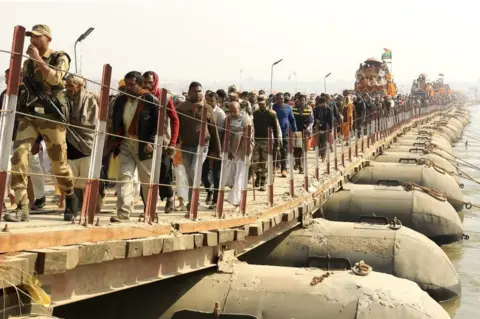 Ankit Srinivas
Ankit SrinivasThe mela (meaning "fair" in Hindi) has been held in Allahabad for centuries now, but it has grown into a mega event in the past two decades.
 Getty Images
Getty ImagesThis year the gathering will be particularly huge and many believe India's Hindu nationalist government has organised it with an eye on key general elections due in the summer.
Massive billboards of Prime Minister Narendra Modi dot Allahabad city and the mela ground. Huge cardboard cut-outs have been placed strategically at the bathing areas.
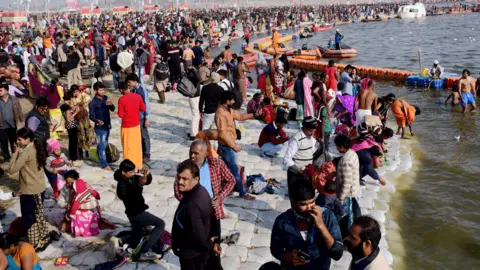 Ankit Srinivas
Ankit SrinivasA temporary tent city, spread over 32 sq km (12 sq miles) has been set up to accommodate the masses, complete with hundreds of kilometres of new roads. Hospitals, banks and fire services have been set up just for the festival, along with 120,000 toilets.
Hundreds of new train services are running to and from Allahabad to tackle the rush of pilgrims and more than 30,000 police and paramilitaries have been deployed to provide security and manage the crowds.
In the run up to the festival, religious sects held daily processions marked by much pomp and show.
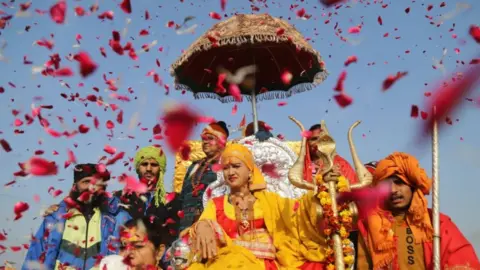 Ankit Srinivas
Ankit SrinivasAt one such procession on Sunday night, there were elephants, camels and horses. Brass bands and drummers played, as religious leaders sitting atop several vehicles threw marigold flowers to thousands of devotees.
On Monday - a day before the official start of the festival - tens of thousands of pilgrims bathed at the Sangam. Some then lit clay lamps and floated them along with flowers in the Ganges.
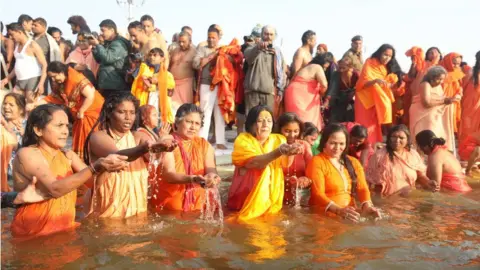 Ankit Srinivas
Ankit Srinivas
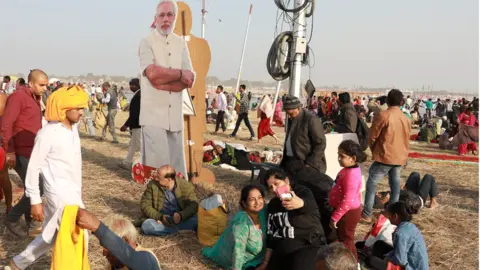 Ankit Srinivas
Ankit SrinivasThe atmosphere at the mela is festive, and the authorities have announced a calendar of music and dance performances. But there's plenty of impromptu entertainment taking place by the roadside, with children performing rope tricks and shows by drummers and ballad singers.
Most pilgrims, however, say they are here to "answer the call of Mother Ganges".
"We believe that bathing here will destroy our sins," farmer Pramod Sharma said.
"The waters here have regenerative properties. Bathing here can cure your ailments. It also removes obstacles from your way," Shahbji Raja said.
 BBC
BBC

Kumbh Mela at a glance
- A pilgrimage in which Hindus gather at points along the Ganges, Yamuna and mythical Saraswati rivers
- This year's event expects 120 million visitors over seven weeks, dwarfing last year's Hajj pilgrimage in Saudi Arabia which drew about 2.4 million
- Astrology determines most aspects of the festival, including its date, duration and location
- The most recent full Kumbh, held in 2013 in Allahabad, was also a Maha (or great) Kumbh, which happen every 144 years. It attracted an estimated 100 million visitors
- A lost-and-found camp was set up in 1946 and has since helped reunite countless family members and friends who get separated in the vast crowds
- This year, 15 lost-and-found camps have been set up. These computerised centres are interconnected and their announcements will be heard across the mela grounds. Details will also be uploaded on Facebook and Twitter to help trace the missing
All images copyright.
